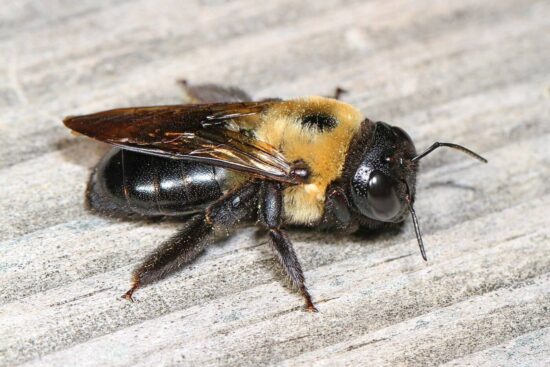If you’ve ever seen a large, fuzzy bee hovering near your deck or wooden fence, you might be wondering whether it’s safe to be around. The good news is that carpenter bees are generally peaceful creatures, but the answer to whether they sting is a bit more complicated than a simple yes or no.
Do Carpenter Bees Sting?
Here’s what you need to know right away: female carpenter bees do have stingers and can sting you, but male carpenter bees don’t have stingers at all. Before you start worrying, though, stings are pretty rare. Female carpenter bees aren’t aggressive by nature and will only sting if you’re handling them, poking around in their nests, or making them feel threatened.
So if you see a carpenter bee buzzing around your yard, there’s no need to panic. Chances are it’s either a harmless male or a busy female who has zero interest in bothering you. Understanding the difference between male and female carpenter bees can help you feel more comfortable around these helpful pollinators.
Understanding Carpenter Bee Anatomy and Who Has Stingers
The easiest way to tell male and female carpenter bees apart is by looking at their faces. Males have white or yellow markings on their heads, while females have completely black heads. If you can get close enough to see this detail, you’ll know exactly what you’re dealing with.
Female carpenter bees are also typically a bit larger and stockier than males. Their bodies are built for the hard work of drilling into wood to create nests. And yes, females have smooth stingers that can sting multiple times without harming the bee. Unlike honeybees that die after stinging once, carpenter bees can sting repeatedly if they feel the need to defend themselves.
Males, on the other hand, have no stinger whatsoever. Nature gave them the intimidating behavior but not the weapon to back it up.
Male Carpenter Bees Are All Bark and No Bite
Male carpenter bees can seem pretty scary when they’re flying right at your face. They hover aggressively near their nests and may buzz around you in what looks like a threatening way. But here’s the truth: it’s all for show. Without a stinger, male carpenter bees are completely harmless to humans.
Their job is to guard the territory and protect the female while she’s busy building the nest and laying eggs. Males take this responsibility seriously, which is why they put on such an impressive defensive display. They’ll hover in front of anything they see as a potential threat, whether it’s a person, another insect, or even a bird.
You might also notice that male carpenter bees seem to stare at you when you get close. This curious behavior comes from their territorial instincts. They’re checking you out to decide if you’re a danger to their home. But remember, no matter how aggressive they act, they literally cannot sting you.
Female Carpenter Bees and When They Sting
Female carpenter bees are the ones with actual stingers, but getting stung by one is unlikely. These bees will only sting if you touch them, try to handle them, or stick your fingers into their nest holes. If you leave them alone, they’ll leave you alone.
Most of the time, female carpenter bees are too busy working to pay any attention to people. They spend their days drilling tunnels into wood, laying eggs, and collecting pollen to feed their young. Unlike honeybees or wasps that aggressively defend their hives, carpenter bees are solitary and don’t have that same protective instinct.
The main situations where you might get stung are if you accidentally grab a female bee, if you’re handling infested wood, or if you poke your finger into a nest entrance. As long as you’re aware of where they’re nesting and give them their space, you should be just fine.
What a Carpenter Bee Sting Feels Like
So do carpenter bees sting in a painful way? If you do get stung by a female carpenter bee, you’ll feel a sharp, burning pain right at the spot where the stinger went in. The area will usually get red and swollen, similar to other bee stings. However, many people report that carpenter bee stings hurt less than honeybee or wasp stings.
The venom contains a substance called melittin, which is a peptide that creates that burning sensation and causes pain. The good news is that carpenter bees have smooth stingers, so they don’t leave the stinger stuck in your skin like honeybees do. This means the venom doesn’t keep pumping into your body after the initial sting.
For most people, the pain and swelling go away within 24 hours. It’s uncomfortable but manageable, especially if you treat it properly right away.
The Science Behind Carpenter Bee Venom
Carpenter bee venom is actually pretty simple compared to some other stinging insects. It’s made up mainly of melittin-like peptides and an enzyme called phospholipase A2. These components work together to cause pain and inflammation, which serves as a defense mechanism to keep predators and threats away.
Melittin is the main ingredient that makes the sting hurt. This peptide causes pain and can damage tissue, which is exactly what the bee wants when trying to defend itself. Interestingly, carpenter bee venom is similar to honeybee venom but may be a bit less potent overall.
The smooth stinger is what allows female carpenter bees to sting multiple times. Since the stinger doesn’t get torn from their body like it does with honeybees, they can defend themselves repeatedly if needed. Fortunately, they rarely feel the need to sting even once, let alone multiple times.
How to Treat a Carpenter Bee Sting
If you do get stung, don’t worry. Treatment is straightforward and you can handle it at home in most cases. Start by washing the area with soap and lukewarm water to keep it clean and prevent infection. Pat it dry gently with a clean towel.
Next, grab a cold compress or ice pack wrapped in a cloth and hold it against the sting site. This will help reduce swelling and numb the pain. Keep the compress on for about 10 to 15 minutes at a time.
If the sting is bothering you, take some over-the-counter pain medicine like ibuprofen or acetaminophen. You can also apply an antihistamine cream to help with itching and swelling. One interesting tip: don’t cover the sting with a bandage. Letting fresh air get to it actually helps it heal faster.
The sting should feel much better within a day or two. Just keep an eye on it to make sure it’s healing normally.
Signs of an Allergic Reaction and When to Seek Help
While most carpenter bee stings are no big deal, some people can have allergic reactions that require immediate medical attention. You need to watch for serious symptoms like difficulty breathing, a swollen tongue or throat, nausea, dizziness, or feeling like you might pass out.
These are signs of anaphylaxis, which is a severe allergic reaction that can be life threatening. If you or someone near you experiences these symptoms after a sting, call 911 right away. If the person has an epinephrine auto-injector (like an EpiPen), use it immediately while waiting for emergency services.
It’s important to know the difference between a normal reaction (pain, redness, and swelling at the sting site) and an allergic reaction (symptoms affecting your whole body). When in doubt, it’s always better to seek medical help.
Carpenter Bees as Beneficial Pollinators
Before you decide that all carpenter bees need to go, consider this: they’re actually excellent pollinators that help your garden thrive. Do carpenter bees sting? Yes, females can, but they also provide some amazing benefits that make them valuable neighbors.
Carpenter bees are especially good at pollinating vegetables like eggplants, tomatoes, peppers, and blueberries. They use a special technique called buzz pollination, where they vibrate their powerful flight muscles to shake pollen loose from flowers. It’s like a little pollen earthquake that helps plants produce better fruits and vegetables.
These bees are also early morning workers, visiting flowers when many other pollinators are still sleeping. They’ll visit a huge variety of flowering plants throughout your garden, helping everything from vegetables to ornamental flowers reproduce successfully. Their long activity season and ability to work in hot weather make them especially valuable pollinators in many areas.
How to Prevent Carpenter Bee Stings
The best way to avoid getting stung is actually super simple: just leave carpenter bees alone. If you see a lone bee flying around, stay calm and still. If it approaches you out of curiosity, it will usually fly away on its own after checking you out.
Never try to touch or handle carpenter bees, even if they seem calm. Don’t swat at them or make sudden movements that might startle them. And definitely don’t stick your fingers into any holes you see in wood, since that’s where female bees might be working on their nests.
If you want to keep carpenter bees from nesting near your house in the first place, paint or seal any exposed wood. Carpenter bees strongly prefer unpainted, weathered wood, so a fresh coat of paint or wood stain can make your deck, fence, or siding much less appealing to them.
Another helpful strategy is to provide alternative nesting sites away from your home. Set up some untreated wood blocks or logs in a corner of your yard where the bees can nest without bothering anyone.


